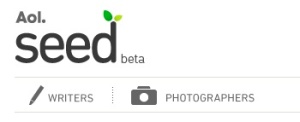Now that I’ve spent time Spool blogging about never writing for free (there has to be some compensation) and the joys (and perils) of freelancing, I thought this would be a great time to talk about one promising possible solution in the realm of making a living writing in the evolving media landscape. I want to highlight one arena that is paying new writers (and longtime ones, too, as I write for them as well). It’s a fairly new content aggregator, which AOL created in Beta late last year, called SEED.
It has suffered some growing pains as the blogosphere has well published, but as it works out its kinks I think this new model of paying journalism may have some legs.
For one, I am a fan of the fact it PAYS for the content it publishes. Nowadays too many web-based publications require free blogging (I’m looking at you HuffPo) and instead of going off again on this, let’s discuss how SEED works. Basically, you sign up for a free SEED account (you have to be a U.S. resident and at least 18 years-old), and from your Dashboard you may claim assignments (there are myriad writing assignments as well as photo assignments – although as I peruse my Dashboard today there are not any available photo assignments). You can search through a bevy of categories to pick assignments that interest you. Once you’ve been published through the system, it actually makes suggested assignments for you to claim, but you can claim any you want. The pay varies depending on the assignment; they primarily range from $10 to $100, but I’ve been told it can go up to $300 once you’re established. There are also deadlines you must heed. SEED buys content on a scale: it will pay the listing price if they accept an article and acquire an exclusive license, 75% of the calculated earnings (i.e. what your story generated from ads, etc.) if it’s a limited license, and although they have not implemented this yet, 25% of calculated earnings if it was published prior for a non-exclusive license.
Their FAQ page says an editor will reject or accept your submission within 5 business days, however, there have been complaints about this. I’ve mentioned a “pro” of the site and that is that it pays for published content, but one “con” is this: any SEED member can claim and submit to an assignment, so you can essentially be competing against other writers (there are thousands signed up, according to one editor) for the same assignment. Therefore, it is possible that you can keep submitting, but never have a story picked up, and hence you will not be paid. Here’s the thing, though, if you pick assignments that are topical and easily pitched somewhere else if it has been rejected by SEED, you can then submit the story elsewhere or use it as content for your own blog. You retain the full rights to your content if it has been rejected.
Also, although it is not a requirement to be a published writer or journalist to participate in SEED, they do have an editorial board and expect journalistic reporting. To help increase your chances of getting published and noticed through this SEED model, I spoke with my editor, Lou Carlozo, for its Money College area (which appears on AOL’s Walletpop.com site) to bring you some insider tips. Full disclosure: for my assignments I am not competing with other writers for the same story, in my case I pitch Lou and he decides if he wants the pitch or not. So, I am not “cattle call” writing as is the case for the general SEED writing pool.
Lou says they have been working on “refining the system” since SEED’s Beta launch. Because it’s an “open submission” process, he suggests picking a category and to “keep hammering away at it. Once you get your first one bought, you can establish a relationship with an editor.” Also, it helps to concentrate on one category as likely that same editor will become more familiar with your work. He says it would be smart to ask for feedback from your editor, even if it’s rejected, as you could get valuable advice from an editor to increase your chances of a submission being bought the next time around.
Lou says you may be thinking short-term, but you should also think long term in regards to the SEED system. “Short term is I want to get my work bought.” Well, you should definitely work to establish rapport with an editor and that begins by writing clean and well-reported copy and finding a way to stand out. And long term? Think “quality, substance and style to get in the regular rotation of AOL writers.” How do you do this? Lou says 1: Be a reporter, do reporting 2: Learn everything you can about the subject you pick for assignment 3: Patience: Sure, you may be really good, but if you’re not bought, remember the editor doesn’t know you yet. Be persistent and if you’re a standout writer, you’ll be remembered 4: When you submit stories, have an avatar. Put a picture up so they can remember you 5: Include a three-sentence bio in the body of your submission along with your email and phone number. That way an editor can reach out to you if need be.
He also gives this tip: “Indicate a willingness in one or two sentences that you’d like more assignments, or if you have ideas. I’d be happy to talk to someone who shows initiative,” says Lou. He also adds that you need to find a way to stand out. It is true you’re competing with thousands of writers, but if you are creative in showing initiative and work to establish a relationship with an editor (“this brings you to the doorstep of an editor” – Lou says all submissions are read by one or more editors) you increase your chances of being noticed in this open submission situation.
“I can reject you 40 times, but the 41st time might get you bank,” says Lou. Think you have what it takes? Sign up and give it a try.
Do you have a good pitch for Money College? Feel free to email Lou Carlozo at Louseed@aol.com. From Lou: General pitches will not be accepted (i.e. “How to save money at Starbucks”). Only pitches pertaining to specific newsworthy items with an original, financial twist will get a reply and possible audition. (i.e. "How Ohio State Students Raised $1,000,000 for Haitian Relief, With Haircuts.”)
Due to the high volume of emails Lou gets, do not expect a reply–though you may well get one. Stress quality over quantity–only one-two pitches per email, please. And finally, PLEASE heed this advice, as this is a big opportunity for you to make a valuable insider connection: make sure you’ve read what is being published in Money College on Walletpop.com (search “Money College” at Walletpop.com), think of a great, topical story that is geared towards college students and finance/budget (not one that has already been published, obviously), and make sure you know the subject inside and out before attempting to pitch it. Remember, every contact you have with an editor is a chance to establish rapport, so make sure your pitch is top notch (editors remember the bad ones, too, which doesn’t bode well for anyone). Finally, if it does get accepted, do the research, report it well and turn it in on deadline. Good luck!


